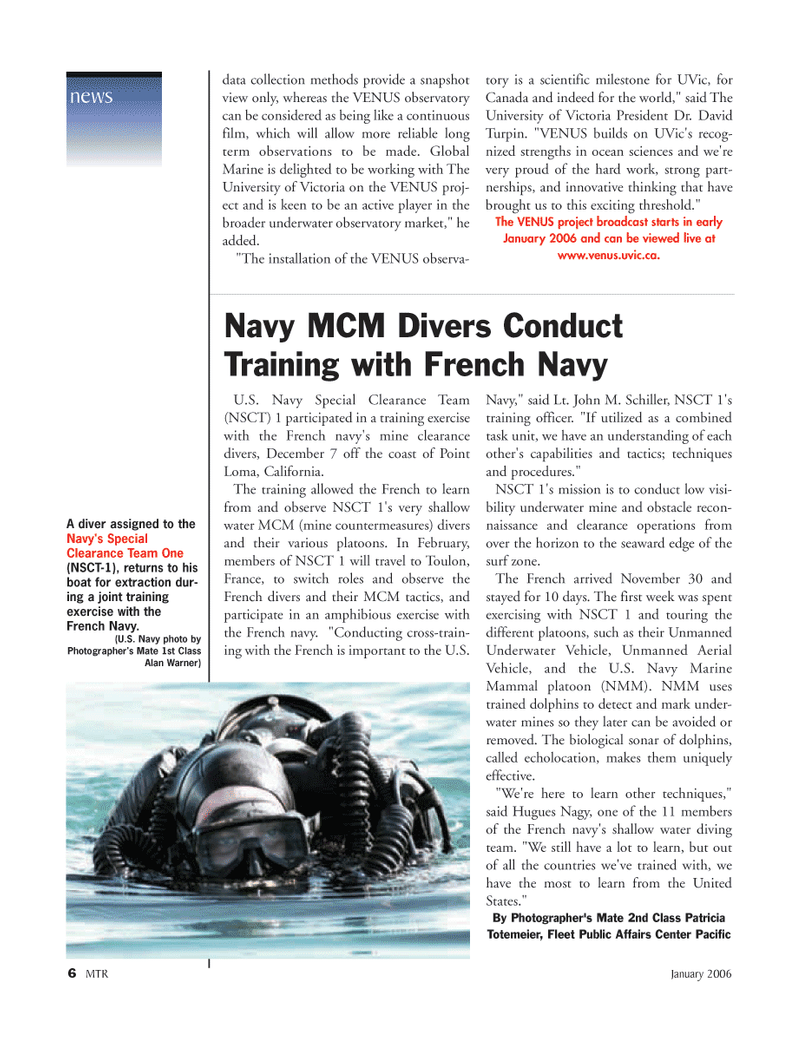
Page 6: of Marine Technology Magazine (January 2006)
Marine Science Institutions
Read this page in Pdf, Flash or Html5 edition of January 2006 Marine Technology Magazine
data collection methods provide a snapshot view only, whereas the VENUS observatory can be considered as being like a continuous film, which will allow more reliable long term observations to be made. Global
Marine is delighted to be working with The
University of Victoria on the VENUS proj- ect and is keen to be an active player in the broader underwater observatory market," he added. "The installation of the VENUS observa- tory is a scientific milestone for UVic, for
Canada and indeed for the world," said The
University of Victoria President Dr. David
Turpin. "VENUS builds on UVic's recog- nized strengths in ocean sciences and we're very proud of the hard work, strong part- nerships, and innovative thinking that have brought us to this exciting threshold."
The VENUS project broadcast starts in early
January 2006 and can be viewed live at www.venus.uvic.ca. news 6 MTR January 2006
Navy MCM Divers Conduct
Training with French Navy
U.S. Navy Special Clearance Team (NSCT) 1 participated in a training exercise with the French navy's mine clearance divers, December 7 off the coast of Point
Loma, California.
The training allowed the French to learn from and observe NSCT 1's very shallow water MCM (mine countermeasures) divers and their various platoons. In February, members of NSCT 1 will travel to Toulon,
France, to switch roles and observe the
French divers and their MCM tactics, and participate in an amphibious exercise with the French navy. "Conducting cross-train- ing with the French is important to the U.S.
Navy," said Lt. John M. Schiller, NSCT 1's training officer. "If utilized as a combined task unit, we have an understanding of each other's capabilities and tactics; techniques and procedures."
NSCT 1's mission is to conduct low visi- bility underwater mine and obstacle recon- naissance and clearance operations from over the horizon to the seaward edge of the surf zone.
The French arrived November 30 and stayed for 10 days. The first week was spent exercising with NSCT 1 and touring the different platoons, such as their Unmanned
Underwater Vehicle, Unmanned Aerial
Vehicle, and the U.S. Navy Marine
Mammal platoon (NMM). NMM uses trained dolphins to detect and mark under- water mines so they later can be avoided or removed. The biological sonar of dolphins, called echolocation, makes them uniquely effective. "We're here to learn other techniques," said Hugues Nagy, one of the 11 members of the French navy's shallow water diving team. "We still have a lot to learn, but out of all the countries we've trained with, we have the most to learn from the United
States."
By Photographer's Mate 2nd Class Patricia
Totemeier, Fleet Public Affairs Center Pacific
A diver assigned to the
Navy's Special
Clearance Team One (NSCT-1), returns to his boat for extraction dur- ing a joint training exercise with the
French Navy. (U.S. Navy photo by
Photographer's Mate 1st Class
Alan Warner)
MTR#1 (1-16).qxd 1/9/2006 2:07 PM Page 8

 5
5

 7
7
